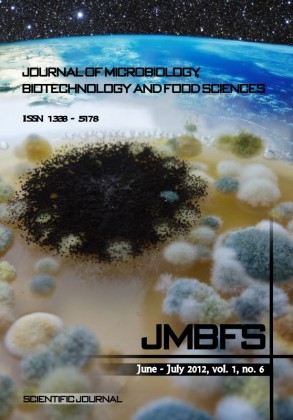CONTROL OF POSTHARVEST TOMATO ROT BY SPORE SUSPENSION AND ANTIFUNGAL METABOLITES OF TRICHODERMA HARZIANUM
Keywords:
Trichoderma harzianum, Biological control, Postharvest, Tomato, PathogensAbstract
Rot of cherry tomato (Lycopersicon esculentum) fruits caused by several fungal pathogens is a detrimental disease leading to substantial yield loses worldwide. Alternaria isolates were the most common fungal species isolated from healthy or rotten fruits. Trichoderma harzianum spore suspension and culture filtrate were tested for their antagonistic activity on controlling tomato fruit rot. T. harzianum isolates suppressed or interfered with the growth of different postharvest tomato fungal pathogens albeit at different degrees. Their culture filtrate inhibited pathogen spore germination possibly due to the released extracellular diffusible metabolite(s). Besides, aberrant morphology of conidia was observed with deformation of hyphal tips. Furthermore, the resulting mycelia appeared desiccated with coagulated protoplasm leading to complete collapse of protoplasm in presence of T. harzianum culture filtrate. Application of T. harzianum spores to tomato fruits decreased disease severity significantly with the most profound effect at higher spore concentrations (108 cells per ml). Similarly, culture filtrate of T. harzianum prevented pathogen spore germination on the surface of tomato fruits leading to decreased incidence of rot symptoms at high culture filtrate concentrations. This work provides strong evidence that T. harzianum is a competent antagonist and its spore suspension and culture filtrate can be used efficiently to control postharvest tomato rot.Downloads
Download data is not yet available.
Downloads
Published
2012-06-01
How to Cite
H. El-Katatny* and Abeer S. Emam, M. (2012). CONTROL OF POSTHARVEST TOMATO ROT BY SPORE SUSPENSION AND ANTIFUNGAL METABOLITES OF TRICHODERMA HARZIANUM. Journal of Microbiology, Biotechnology and Food Sciences, 1(6), 1505–1528. Retrieved from https://office2.jmbfs.org/index.php/JMBFS/article/view/7225
Issue
Section
Microbiology
License
Copyright (c) 2012 Momein H. El-Katatny* and Abeer S. Emam

This work is licensed under a Creative Commons Attribution 4.0 International License.
All papers published in the Journal of Microbiology, Biotechnology and Food Sciences are published under a CC-BY licence (CC-BY 4.0). Published materials can be shared (copy and redistribute the material in any medium or format) and adapted (remix, transform, and build upon the material for any purpose, even commercially) with specifying the author(s).

